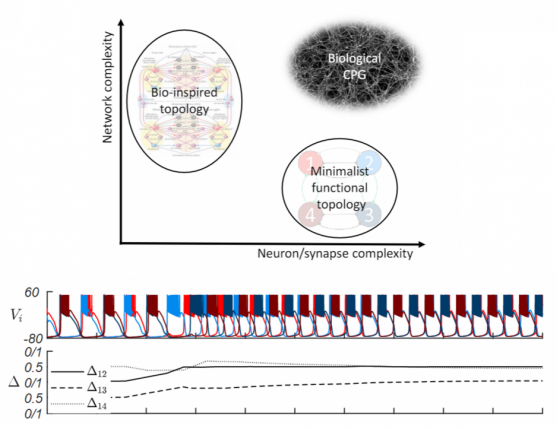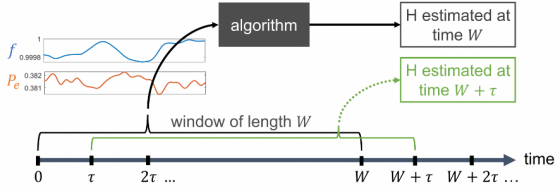Modeling of biologically plausible central pattern generators (CPGs)

Summary
Central pattern generators (CPGs) are small neural circuits that can autonomously produce various rhythmic patterns of neural activity, also in the absence of sensory feedback or inputs from higher areas. CPGs underlie many behavioral rhythmic activities and they bear a fundamental function in both invertebrate and vertebrate animals as they determine multi-phase locomotion: the innate motor behavior that requires sequential activation of body muscles in a coordinated way. Although CPGs can produce rhythms without sensory inputs, sensory feedback is important to adapt and fine-tune the activity of the CPG to the environment. Moreover, their activity is modulated through the influence of hierarchically higher areas, which can, for example, prompt transitions between gaits.
Understanding locomotor CPGs is important for designing effective gait rehabilitation strategies for those with neurological injuries. The study of CPGs is also relevant in developing bio-inspired engineering solutions: there are several interesting properties of CPGs that have been proven to be helpful for the control of locomotion in robots.
The modulation from higher areas that control the synchronization between CPG neurons and triggers gait switches, is commonly integrated into CPG models by directly affecting the synaptic conductance strengths. However, in real CPGs changes in conductance values are the result of long-term synaptic plasticity, and therefore they are hardly a cause for quick gait switches, which can instead be accounted for more realistically by short-term neuromodulation. This short-term neuromodulation lacks in most CPG models.
The aim of our research is to
- develop more realistic and functionally accurate multi-gait CPG models that account for short-term neuromodulation in a bio-physically plausible way;
- define strategies for the systematic tuning of the CPG parameters.
Relevant publications
V. Baruzzi, M. Lodi, M. Storace, A. Shilnikov. Towards more biologically plausible central-pattern-generator models. Physical Review E. Vol. 104, n. 6, pp. 064405, 2021.
V. Baruzzi, M. Lodi, M. Storace, A. Shilnikov. Generalized half-center oscillators with short-term synaptic plasticity. Physical Review E. Vol. 102, n. 3, pp. 032406, 2020.
M. Lodi, A. Shilnikov, M. Storace. Design principles for central pattern generators with preset rhythms. IEEE Transactions on Neural Networks and Learning Systems. Vol 31, n. 9, pp. 3658-3669, 2019.
Cluster synchronization as a tool to reconcile structural and functional connectivity in brain networks

Summary
The synchronized activity of groups of brain areas is essential for the transmission and processing of information. This phenomenon is highlighted by non-invasive imaging techniques (fMRI, EEG) which allow us to observe the functional activity of the brain. Diffusion-weighted magnetic resonance imaging (dMRI), also non-invasive, allows instead to approximately reconstruct the anatomy of the brain connections. To date, however, the relationship between structure and function is still not fully understood.
In order to reconcile these two aspects of the study of brain networks, the mathematical concept of cluster synchronization in networks of nonlinear dynamical systems can be applied to the case of groups of brain areas with approximately synchronized activity, by exploiting functional data to obtain information on the strength of structural connections.
The aim of our research is to
- develop data-driven optimization processes to refine structural data according to the observed functional activity;
- obtain models of the brain network of individual subjects based on structural and functional experimental data, at different resolution levels.
Estimation of inertia in power grids with renewable energy sources (RES)

Summary
In recent years, the presence of renewable energy sources (RES), like photovoltaic and wind power plants, has significantly increased in power grids. Including renewable energy sources in power systems, however, poses challenges in terms of system stability. Each synchronous generator, and also the power grid as a whole, is characterized by the inertia constant, which is a measure of the system's ability to counteract the frequency changes triggered by external disturbances and is thus a key factor in determining frequency stability.
In a power system composed only of synchronous generators, the source of inertia is the kinetic energy of the rotating masses. In this condition, the inertia constant of the power grid remains steady over the long term. On the other hand, renewable energy sources are interfaced with the grid through power converters, which have no intrinsic inertia. To combat the decrease in system inertia and effectively integrate RES into power grids, various control strategies able to provide synthetic inertia have been developed. Even so, the power that can be provided by renewable sources is intermittent by nature, making the global system inertia time-varying.
Consequently, the need arises for methods able to estimate the inertia constant in a continuous fashion, under normal operating conditions, relying on ambient measurements that can be collected through commonly used phasor measurement units.
The aim of our research is to
- develop algorithms for inertia estimation that fit into this category;
- investigate how internal delays and signal distortions in synthetic inertia controllers affect the synthetic inertia provided to the grid.
Research projects
DCNanoSyn: Distributed DC nanogrids to restore the system frequency and dynamic stability providing SYNthetic inertia and damping.
ViStoFaRe: Virtual Storage per la Fast Reserve e servizi integrati di inerzia sintetica, peak shaving e load levelling.
Relevant publications
V. Baruzzi, A. Rosini, M. Lodi, A. Bonfiglio, A. Oliveri. Synthetic inertia estimation in the presence of measurement noise and delays: An application to wind turbine generators. International Journal of Electrical Power & Energy Systems. Vol. 166, pp. 110511, 2025.
A. Bonfiglio, M. Lodi, A. Rosini, A. Oliveri, R. Procopio. Design, realization and testing of a synthetic inertia controller for wind turbine power generators. Sustainable Energy, Grids and Networks. Vol. 38, pp. 101234, 2024.
